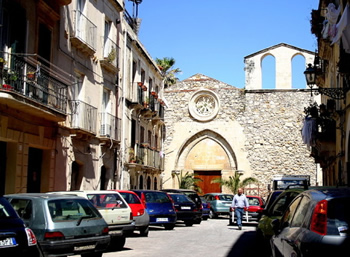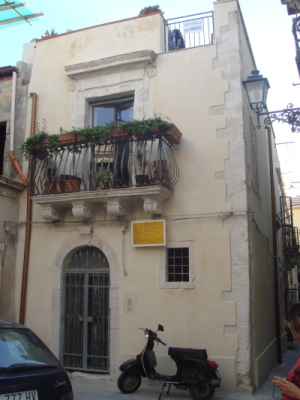 |
| The facade of San Giovanni Battista in Syracyse. |
Piazza del Precursore in Syracuse
This square is located in the heart of
the Giudecca
(Jewish quarter) of Syracuse.
Two monuments of historical interest face
it:
San Giovanello
(San Giovanni Battista), former synagogue
The latest research has allowed for the
identification in the church of San Giovanni Battista of what was the Jewish
synagogue, whose location had been lost in memory for centuries.
Research carried out during restoration
work also found that the synagogue encased a large enclosed courtyard,
which was broken up to create the square.
The church of San Giovanni Battista is
left to us without the roof, and is used occasionally for summer concerts
and cultural events.
The house of Jewish worship, however, had a different orientation and a different point of entry than the church into which it was converted, as revealed in the front, where the beautiful Gothic side entrance, promoted to the rank of main entrance, is curiously off-center because of a somewhat hasty adaptation.
After the expulsion of the Jews who rejected forced conversion in 1492, the synagogue was turned into a church for the many who were resigned to being baptized in order to stay in their homes and was thus "appropriately" named after the holy baptizer par excellence by definition, John the Baptist.
Hebrew inscription found during restoration work has finally returned to memory the first use of this sacred space; after many years it was believed that the synagogue had been identified rather with the church of St. Philip the Apostle.
 |
| The house where Mario Minniti lived. |
Minniti was a fellow student and housemate of Michelangelo da Caravaggio (until 1600), at a time during which both were young painters seeking their fortunes in Rome.
Penniless, the two posed for themselves as models, and it was such that art historian Christoph Frommer recognized the face of Minniti immortalized in the Bacchus by Caravaggio in the Uffizi, in the Lute Player in the Hermitage, and as the boy from The Fortune Teller in the Capitoline Museums.
When Caravaggio arrived in Syracuse in 1608, fleeing from Malta, his former friend recognized him and introduced him to the artistic community of city. Thanks to this help, Michelangelo painted the famous painting The Burial of St. Lucia, which is still preserved in the city.
We know, however, that Caravaggio did
not stay in this house, but sought asylum with the Capuchin friars,
next to the Quarries
of the Capuchins.
However, it’s not hard to imagine that
the house of the one friend that the painter had in Syracuse was also frequented
by him.
In addition, it’s worth adding that we know about the former location of the entrance to the courtyard of the synagogue from a petition by Minniti, who asked and obtained permission to demolish the arch of the main door, which hung over the alley that runs along his home.
How to Reach “San Giovannello” from the Algilà Ortigia Charme Hotel.
The former church of San Giovanni Battista and the adjacent house of Mario Minniti are found a few hundred meters from the Hotel Algilà. For this reason it is advisable to reach it on foot, walking along the streets of what was once the Giudecca.
Accessibility
The church of San Giovanni Battista in
Syracuse was deconsecrated and is not open to the public, except
on the occasion of public events, for example concerts.
The same holds true for the former house of Mario Minniti, which is privately owned and which can be seen only from the outside.
Back to TOURISM IN SYRACUSE, SICILY